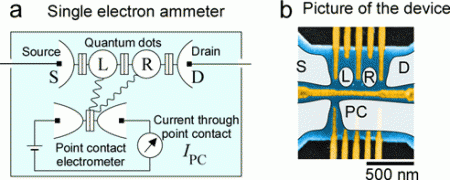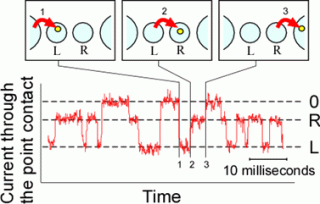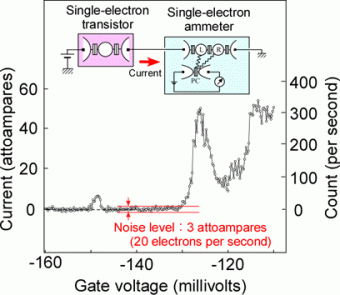Single-electron ammeter based on bidirectional counting of single-electrons

Nippon Telegraph and Telephone Corporation, in collaboration with the Tokyo Institute of Technology, the Japan Science and Technology Agency, and the Tohoku University, has successfully demonstrated an extremely sensitive ammeter, in which the flow of one electron in either direction can be detected in real time. The single-electron ammeter can be used to measure extremely small currents that cannot be measured with any existing meter and to analyze the motion of individual electron. It will be useful for studying nanoelectronics and developing quantum information technologies.
This work was published in Science magazine, June 16 issue.
Conventional sensitive ammeter requires millions of electrons to detect as a current.
The new single-electron ammeter with single-electron sensitivity integrates two quantum dots and a point contact in a semiconductor device as shown in Fig. 1a. An electron entering or escaping from one of the quantum dots influences the current flowing through the point contact, and thus the change in the electron occupation in a quantum dot can be monitored. Two quantum dots are required in order to identify the direction from which the electron has entered or to which it has escaped. This bidirectional counting is essential for making a single-electron ammeter.

NTT researchers fabricated the single-electron ammeter using semiconductor nanofabrication techniques (See the scanning electron micrograph in Fig. 1b). Each quantum dot (L and R) has a diameter of about 100 nanometers and is placed about 200 nanometers from the point contact.
When an electron travels through the two quantum dots, the current through the point contact shows three different values depending on the location of the electron as shown in Fig. 2. Jumping between these values can be understood as, for example, an electron entering the left dot (1), moving to the right dot (2), and escaping to the right lead (3). In this way, a single-electron flow can be detected precisely and average current can be obtained by counting the net electron flow.
In order to demonstrate the performance of the single-electron ammeter, scientists connected a single-electron transistor, which is a typical nanoelectronics device, to the ammeter as shown in the inset to Fig. 3. The obtained current flowing through the single-electron transistor shows some current peaks as in Fig. 3, which is a typical characteristics of the single-electron transistor. The measured current in the range of a few to tens of attoampares (atto means 10-18; one-billionth of a billionth), which cannot be measured with any existing current meter. The current noise, 3 attoampares peak-to-peak, is more than three orders of magnitude smaller than that in a conventional current meter.
Moreover, the correct path of an electron in the device can be traced, for instance, three forward steps followed by two backward steps. This fluctuation, current noise, arises from the particle behavior of an electron (quanta) and depends on the interaction between electrons. The single-electron ammeter would be useful for investigating quantum electron transport.

Photon counters, in which individual photons can be counted, have been widely used to detect faint light. Similarly, the present single-electron counter should be useful for detecting extremely small current in various applications. It should be especially useful for studies on nanoelectronics, which seek to examine electron transport through nanostructures, single molecules, and biological cells, and often require measurement of extremely small currents.
Combining the ammeter with a device that converts photons or electron-spins to electronic charges could lead to the development of sensitive detectors for light or magnetic fields. Furthermore, statistical analyses of current noise measured with the single-electron ammeter would identify quantum entanglement, in which quantum information is shared between two separated electrons.
Source: Nippon Telegraph and Telephone Corporation




















